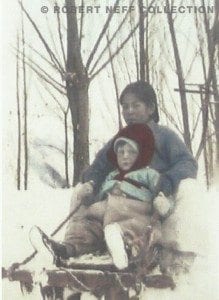
During the late Joseon era, Koreans were well-known for their fondness for children—not only their own, but foreign children as well.
While many children thrived on the attention, others did not. Annie Heron, who was born in Seoul in 1886, recalled waking up one morning to the sound of her papered door being punctured by a mob of fingers. It was through these impromptu peepholes that the curious crowd hoped to get a glimpse of the little Caucasian girl.
<- Sledding in the winter, circa 1920-1930
Annie was determined to put a stop to it so she bound up and rushed to the door, threw it open and began to berate the crowd in Korean for their lack of manners. Suddenly she heard one of the astonished spectators comment that the young girl looked the same as they [the Koreans] did—except she had whiter skin. That was when Annie realized that in her exuberance she had gotten up with not a stitch of clothing on.
Some Western children were cared for by Korean nannies or amahs and also had Korean friends. Many Western boys learned how to battle with tops and kites from their Korean friends while the girls played together on seesaws. Horace H. Underwood, born in 1890 in Seoul and the son of one of the earliest Western missionaries in Korea, was especially favored by the Korean boys in his neighborhood. According to his mother, when he walked the streets of Seoul he was often followed by large crowds of Koreans boys all eager to be his friends. They viewed the young brown-eyed Western boy as “a rare toy and did their best to entertain him.”
While his mother may have been pleased with his ability to get along with the other children, others were worried. A couple of decades later, Horace’s wife warned that a Western boy was “apt to claim and secure a leadership which tends to a swollen and unhealthy idea of his own importance and a tendency to be ‘bossy.’”
Douglas Bray Avison, the son of a Canadian missionary, was born in Seoul in 1893 and often played with Korean children. Unlike many of the other Western children, he had somewhat of a free reign and roamed about the city with his Korean friends.
Sometime in the early 1900s, Avison and a group of Western friends decided to form their own exclusive and independent country on the slopes of Namsan. Eventually, however, they decided to allow some Korean boys to join their country—but there was a requirement. Each of the Korean boys had to have his long hair cut off.
Avison recalled:
“Knowing that willing consent
could not be had from the parents to cut off the long braided pigtails which were then the fashion of Korea, we decided to do the barbering ourselves without asking permission.”
Avison neglected to say what happened next but undoubtedly the Korean boys’ parents were less than pleased.
But the lives of Western children in Korea were not always filled with fun and mischief—they were also filled with fear. Muriel Lewis recalled that she was often afraid:
“There was a lot that was frightening such as the sound of a sorceress beating her drum and yelling to frighten the devils from a sick person, the beggars who roamed the countryside especially the ones with leprosy with missing fingers and toes who sat on our porch demanding food, the bulls who pulled the oxcarts and occasionally went mad and broke loose and ran down the road bellowing, the half-starved Korean dogs who were never shown any affection and were vicious and menacing, and the insane who roamed homeless or were placed in cages in the family’s yard.”
There was also death. The Seoul Foreigners’ Cemetery at Yanghwajin (near Hapjeong subway station) is filled with a large number of children’s tombs. These tombs—some marked with broken pillars symbolizing a life taken early—bear witness to the fact that living in Korea a hundred years ago was a calculated risk.
 <- Korean children circa 1905
<- Korean children circa 1905
Robert Neff has authored or co-authored several books including Korea Through Western Eyes and The Lives of Westerners in Joseon Korea. He currently writes a twice-weekly column for the Korea Times entitled “Did you know?” as well as a twice-monthly historical column for the Jeju Weekly.



